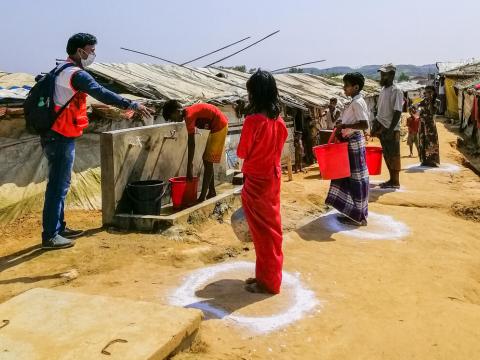Are children forgotten in the response to the pandemic?

Across Asian developing countries, COVID-19 is a gigantic nemesis that can paralyse their already frail and inadequately prepared health system. Overcrowded health facilities combined with a shortage of Personal Protective Equipment (PPE) for health workers put immense pressure on the health systems. Unsurprisingly, other services might have to wait, such as pregnancy care check-up, or immunisation services for children.
Fortunately, some countries keep essential health services for children to remain available. India’s Ministry of Health and Family Welfare postponed the Village Health Sanitation and Nutrition Day (VHSND) but immunization is available at the facility level. Indonesian Pediatric Society or IDAI recommends parents to continue immunization for their children, and health services should offer these services with appropriate infection control, as it is critical for their health and survival.
Where are the children in this COVID-19 situation?
COVID-19 severely affects mainly the elderly, the chronically ill, whereas young people and children usually have mild symptoms or are asymptomatic. However, they might progress into a more severe situation such as pneumonia.
If children and their families do not have access to general public health care, this will increase the risk for other preventable diseases and/or malnutrition.
On top of health impacts, quarantine also affects children and their families. To date, 195 countries have partial or full closure of schools, which reduces their capacity to learn and increases the risk of child abuse and other protection issues.
By studying previous disease outbreaks, we learn that children’s lives might be threatened by COVID-19 even more. World Vision’s report, ‘COVID-19 Aftershocks’ warns that the secondary impacts of the pandemic could threaten the lives of up to 30 million children. A combination of pre-existing weak health systems, populations with high need, and COVID-19 may lead to catastrophic mortality for children.
With the closure of businesses, everyone’s livelihood is impacted, but the poorest and vulnerable children will suffer the most. Even before COVID-19, they lack social protection, rights at work and decent working conditions. Now, their lives are just getting worse.
Caregivers who experience increased stress and lacking resources will not be able to care for and protect their children. What will happen to those children, whose caregivers succumb to the virus, or whose families’ livelihoods are disrupted? Governments and the communities need to find ways to support these families to meet their basic needs and ensure Mental Health and Psycho-Social Support (MHPSS) services available for them.
Along with the medical teams, the frontline Community Health Workers (CHWs) or community health volunteers play a crucial role in COVID-19 response. They are mobilized into the community, often without protective equipment, to provide important information about symptoms of COVID-19 and teaching people about hand-washing with soap. The CHW’s regular work in Maternal Child Health and Nutrition programmes, such as Growth Monitoring and Promotion, home visitation and counselling of mothers and infants, has to stop until government and NGOs find ways to continue these services while ensuring everyone’s safety.
COVID-19 is a new threat, but for years, people in Asia have been living together with other dangerous diseases, such as Tuberculosis, Malaria, HIV, Dengue Fever, and Rabies. CHWs and volunteers have long experience in doing communicable-disease prevention. Still, COVID-19 is the “game-changer” – forcing governments, NGOs, CSOs and FBOs to find new ways of working to ensure the continuation of health and nutrition program even during an outbreak. Some fundamental questions trigger the need for creativity:
- How to do a behaviour change program when everyone has to stay home?
- How to use technology to assist the work of CHWs and volunteers?
- How to provide Mental Health and Psychosocial Support (MHPSS) to caregivers and children impacted by COVID-19?
In Asia-Pacific, World Vision seeks to find solutions in collaboration with the governments, UN agencies, other NGOs and partners. We have been responding in the countries hit by COVID-19, such as China, Bangladesh, Philippines, India, Indonesia, and Thailand. Firstly, by promoting hygiene practices and physical distancing, important to prevent COVID-19. We also continue with important prevention and treatment of malnutrition among children and other childhood illnesses.
World Vision is calling on governments to find ways of expanding access to essential health services, especially for children, the most vulnerable and those at risk. Community Health Workers and volunteers equipped with COVID-19 specific response training and wearing appropriate protective gear are crucial for this work. Additionally, governments need to ensure that COVID-19 diagnosis and treatment are free of cost. Civil societies, private sector, academia and research institutions need to collaborate with governments in scaling-up digital platforms for disease surveillance, while diagnosis and case monitoring are affordable and available in remote locations.
World Vision appeals that any response to a pandemic such as COVID-19 should be as integrated as possible, putting children at the centre and covering the sector of health, nutrition, psychosocial, child protection, education, and livelihood. It is not just the role of governments to think of the poor; it is everyone’s responsibility. Children will be the future of each country, so governments and communities need to develop strategies and policies to protect and enable children to grow in a safe and supported environment.
---ends---
About the author: Esther Indriani is the Technical Advisor for Health and Nutrition for World Vision International.